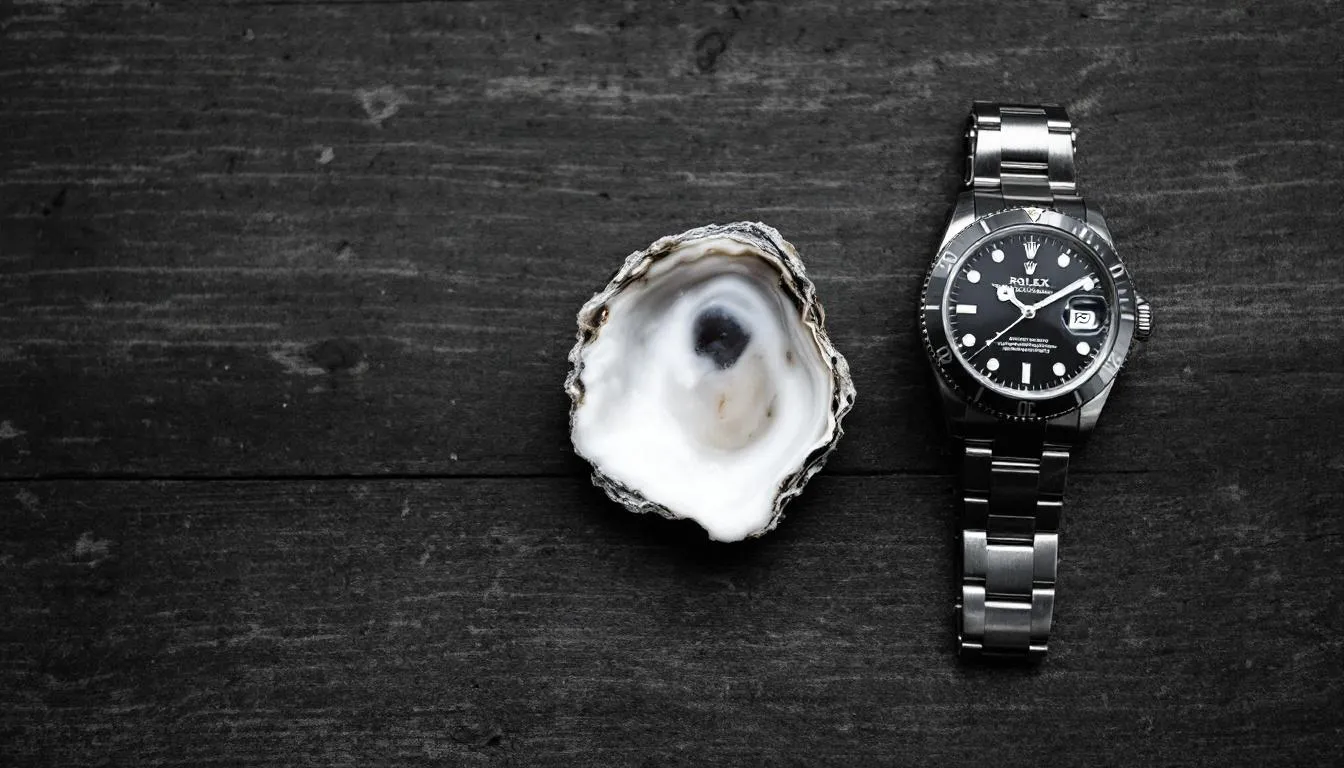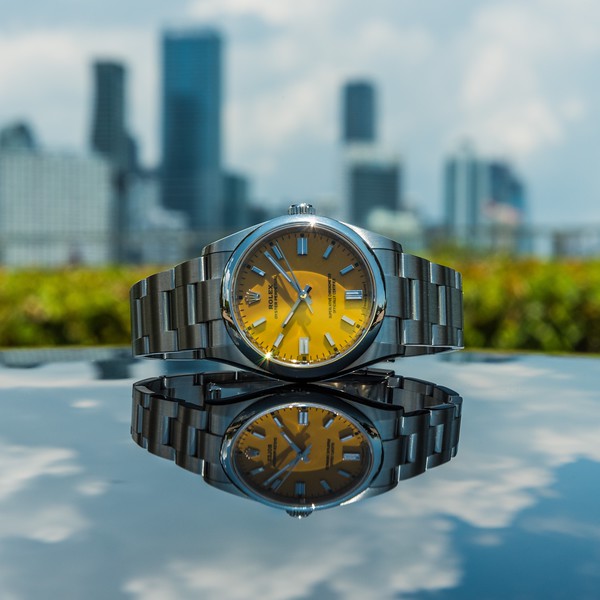Ever wondered why Rolex watches carry the Oyster name? The answer is more straightforward than you might think, but the story behind it is pretty amazing. It all comes down to a revolutionary case design from 1926 and Hans Wilsdorf’s moment of inspiration at a dinner party. Let’s dive into how a stubborn shellfish inspired one of watchmaking’s most iconic innovations.

The Direct Answer: Oyster Origins
Rolex is called oyster because of the revolutionary waterproof case the brand introduced in 1926. Rolex founder Hans Wilsdorf drew inspiration from the oyster mollusk’s protective shell - just like an oyster hermetically seals to protect the pearl inside, the rolex oyster case protects the delicate movement within.
The analogy wasn’t just poetic - it was practical. Wilsdorf reportedly coined the name while struggling to open an oyster shell at a dinner party, realizing both his watch case and the oyster required special tools to open. This hermetic sealing made the rolex oyster case the world’s first truly waterproof and dustproof wristwatch case design.
Before this breakthrough, early wristwatches were vulnerable to water, dust, and moisture damage. The rolex oyster solved this fundamental problem, making luxury watches practical for daily wear in any condition.
The Birth of the Oyster Case in 1926
Hans Wilsdorf set out to solve watchmaking’s biggest challenge: creating a sealed watch case that could withstand real-world conditions. The result was the first waterproof wristwatch that actually worked in practice.
What made the oyster case revolutionary were its key innovations:
-
A screw down crown that locked tightly against the case
-
A screw down caseback and bezel that sealed against the middle case
-
Specialized gaskets that eliminate water and dust entry points
-
Integration of designs from Paul Perregaux and other innovators
The screw down crown was especially clever - it allowed winding and time-setting, then locked everything in place to maintain the waterproof seal. Previous attempts used cork or lead seals that weren’t durable enough for daily use.
That dinner party moment when Wilsdorf struggled to pry open an oyster shell crystallized his vision. Both the oyster and its watch case required special tools to open, emphasizing their secure, sealed nature. The name Oyster became more than just product terminology - it defined the brand’s core philosophy.
Mercedes Gleitze and the English Channel Test
In 1927, Hans Wilsdorf saw the perfect opportunity to prove his Rolex Oyster watch could handle extreme conditions. Mercedes Gleitze, a young English swimmer, wore a Rolex Oyster around her neck during her 10-hour English Channel swim.
The test was brutal - frigid saltwater, constant movement, and over ten hours of exposure that would destroy any normal watch. When Mercedes emerged, the Rolex watch was still running perfectly. This wasn’t just a stunt - it was definitive proof that the waterproof oyster case actually worked.
Rolex published full-page advertisements in the Daily Mail for an entire month, celebrating this achievement. The headline called it the “wonder watch” that survived the ultimate aquatic test. This marketing campaign launched Rolex’s testimonial approach, where real achievements by explorers and athletes endorsed their watches.
The Mercedes Gleitze swim marked the birth of the tool watch concept - luxury timepieces built for extreme conditions. It established the brand’s reputation for creating watches that could handle whatever life threw at them.
Evolution to Oyster Perpetual
The next major breakthrough came in 1931 when Rolex introduced the perpetual movement to complement the Oyster case. The perpetual rotor - a semi-circular weight that moved with the wearer’s wrist - provided automatic winding that eliminated the need for daily manual winding.
This combination created the Rolex Oyster Perpetual - the first waterproof wristwatch with a self-winding mechanism. The Oyster Perpetual collection became the foundation for nearly every modern Rolex design.
Key benefits of the Oyster Perpetual system:
-
Waterproof protection from the sealed watch case
-
Automatic movement that wound itself through daily wear
-
Convenience of never needing manual winding
-
Reliability that made luxury watches practical for active lifestyles
The Oyster Perpetual range expanded to include specialized models like the gmt master for pilots, the Sea Dweller for diving, and the Cosmograph Daytona for racing. Each watch featured the core oyster case technology adapted for specific professional needs.
Today’s Oyster Perpetual Day-Date, with its straightforward time-only dial, remains the brand’s entry-level model while showcasing this foundational technology.
Technical Features of the Oyster Case

Modern Rolex Oyster cases represent nearly a century of continuous refinement. The middle case uses premium materials - typically 904L stainless steel (now called Oystersteel), 18ct gold, or platinum. The 904L steel offers superior corrosion resistance, especially in saltwater conditions.
The waterproof sealing relies on sophisticated crown systems:
-
Twinlock: Uses multiple gaskets for standard water resistance
-
Triplock: Employs up to 10 sealing components for dive watches and higher depth ratings
The fluted bezel wasn’t originally decorative - it provided grip points for the specialized tools needed to screw the bezel tightly onto the case. This functional design became an iconic aesthetic element, especially on models like the Oyster Perpetual Date.
Modern Oyster Components
The complete oyster system includes several integrated elements:
|
Component |
Function |
Key Features |
|---|---|---|
|
Oyster bracelet |
Secure attachment |
Three-link design, Oysterclasp closure |
|
Winding crown |
Sealing and operation |
Screw-down system, multiple gaskets |
|
Case construction |
Protection |
Hermetically sealed case, solid lugs |
|
Crystal |
Visibility and sealing |
Sapphire crystal, pressure-resistant |
The oyster bracelet complements the case with its rugged three-link design and secure closure system. Modern versions include the Easylink extension for comfort adjustments without tools.
Only authorized service centers can open Rolex Oyster cases using specialized tools, maintaining both technical integrity and the brand’s exclusivity. This ensures proper water resistance after any service work.
The Oyster Legacy in Modern Rolex

Nearly every contemporary Rolex sports and professional watch uses Oyster case technology. The oyster models span from the basic oyster perpetual with its clean dial to complex pieces like dive watches rated for extreme depths.
The minimum water resistance rating for all Rolex Oyster cases is 100 meters, with many models exceeding this significantly. This practical durability means these watches can be worn regularly in virtually any environment.
Notable Oyster Perpetual family members include:
-
Submariner: The definitive dive watch with rotating bezel
-
GMT-Master: Dual time zone capability for travelers
-
Day-Date: The prestigious “President’s watch” with full calendar
-
Datejust: The versatile dress-sport hybrid
The brand’s reputation rests largely on the reliability and prestige of oyster technology. From Sir Edmund Hillary wearing a Rolex on Everest to modern professional endorsements, the Oyster case continues to prove itself in extreme conditions.
Even on the secondary market, oyster refers to a guarantee of quality and durability that maintains value over time. The straightforward engineering philosophy behind the original oyster shell analogy still drives modern Rolex innovation.
Conclusion
The Rolex Oyster name connects directly to Hans Wilsdorf’s 1926 breakthrough in waterproof case design. What started as an analogy to an oyster shell’s protective qualities became the foundation for nearly a century of horological innovation.
From Mercedes Gleitze’s channel swim to modern professional achievements, the oyster case has proven itself as the ultimate fusion of luxury and utility. Whether you’re considering your first rolex or adding to an established collection, understanding the oyster heritage helps explain why these watches command such respect and retain their value.
Ready to explore the legendary oyster perpetual collection? The experts at G&G Timepieces can guide you through the full range of oyster models and help you find the perfect piece for your lifestyle and goals. Reach out to discover which oyster watch belongs on your wrist.





